|
Dr. Tough posted:Well they'll probably convert by the 11th century because being an unreformed pagan by then starts to suck They have three or more holy sites on the isles, I believe, enough to reform with just a little luck.
|
|
|
|

|
| # ? Apr 28, 2024 00:28 |
|
Lord Cyrahzax posted:The world has been consumed by heathens and heretics! God has abandoned us, His ungrateful and rebellious children! Do we not deserve it? Have we not seen the warnings, the signs?! There is no hope left, no salvation, only the rule of heathen tyrants on earth, and the rule of Satan below. That is all that awaits humanity! That is such druj. Ahura Mazda protects and guides humanity as the light of truth reaches the unbelievers. The heretics spread within the Christian lands merely show the follies of the religion.
|
|
|
|
Britannia is back, baby! But not in the way I wanted  Now that Septimania is officially heretical, I say we march down there and liberate those poor Orthodox Romans!
|
|
|
|
Raserys posted:Britannia is back, baby! But not in the way I wanted Can't holy war mere schismatics, have to be actual heretics.
|
|
|
|
I hope Zoroastrianism makes its way into Europe somehow.
|
|
|
|
Fox Ironic posted:I hope Zoroastrianism makes its way into Europe somehow. In the border regions between the Islamic Caliphate and the Sassanid Empire the religions of Islam and Zoroastrianism meld together to form a new faith that unites the two in faith and eventully through shared royal blood. Behold Zoroastrianislam. There is no God but Allah and Ahriman is the eternal enemy of Truth. The Lie will be cleansed from Europe as the Fire of the Great Prophet lead the armies of the Truth to eradicate the demon empires of the Romans.
|
|
|
|
A syncretism event would be pretty great.
|
|
|
|
I blame everyone for not taking the Islamic Sassanid Empire option when we had the chance.
|
|
|
|
Time for a Crusade to rechristianize the land where Constantine started his quest to Christianize all of Europe!
|
|
|
|
GSD posted:I blame everyone for not taking the Islamic Sassanid Empire option when we had the chance. You're saying that as if what we got wasn't better!
|
|
|
|
Chapter 26: Shadows and Lights 869-889 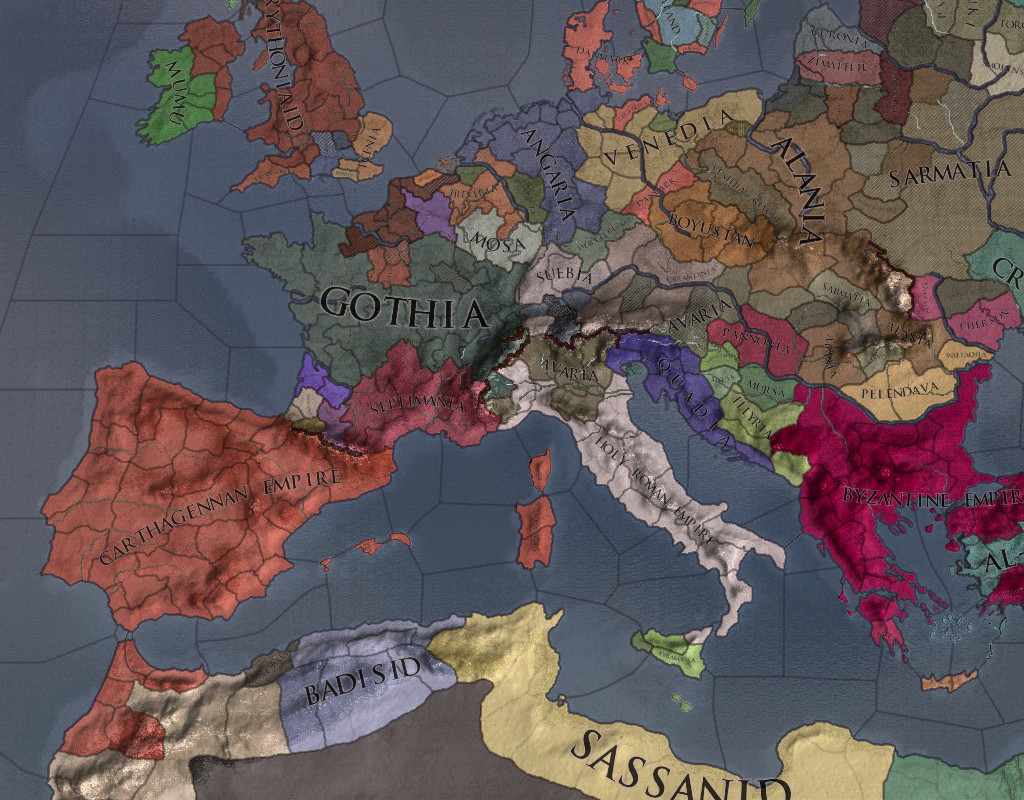 Europe in 869 The Gothic-Papal War of 869 was, in many respects, not the highlight of King Thiudareiks IV’s reign that some later Orthodox writers would contend. Pope Hilary II ‘the Wolf’, ruler of the Italian ‘Holy Roman Empire', was certainly a capable general in own right, and able to call upon nearly twenty thousand men to fight his battles, but the Goths were not going to fight against the Papacy alone. 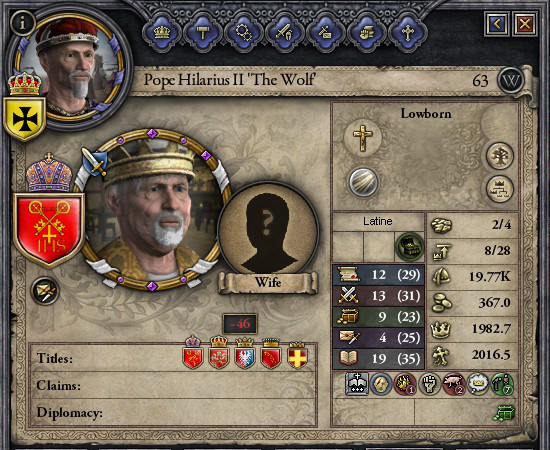 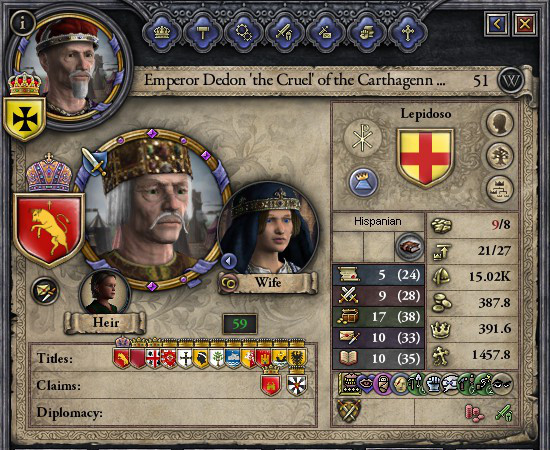 Allied to the Goths by marriage, Emperor Dedon the Cruel was then ruler of the Carthagennan Romans. Like the Goths themselves, alone he was not able to muster as many men as the HRE could, but combined with Thiudareiks’ men into a combined army, a formidable force could be raised. When the Gothic king called up Dedon’s help, the Hispanian emperor jumped at the chance to trounce the Roman Catholics of Italy and their schismatic leader. 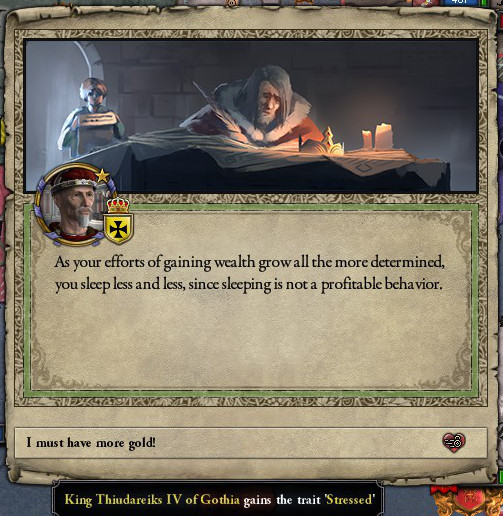 The work of merely coordinating the combined Gothic-Roman forces, working out a rendezvous point, and coercing Gothic and Carthagennan dukes to at the very least tolerate each other, on top of Thiudareiks’ regular involvement in the kingdom’s stewardship, put enormous amounts of stress on the king. His health began to suffer- the royal chronicles note that relics of Saint Marius were brought to the king’s personal estates on the outskirts of Lugdunum, along with a small choir to continuously chant prayers. It is very likely that this did little to reduce the king’s stress. 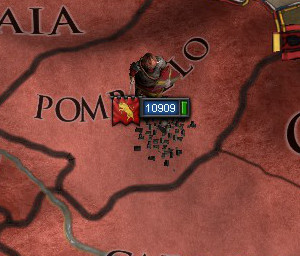 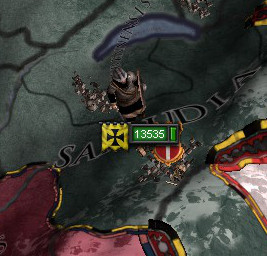 Nonetheless, the king’s work paid off, and a large portion of the Roman and Gothic armies successfully met in the Western Alps, before crossing into Italy and engaging with Papal forces in the Tuscan countryside near Pistoria. Nearly evenly-matched, the allied forces, led by the Duke of Gothonia, managed to deliver a nearly killing blow in the first major battle of the war. 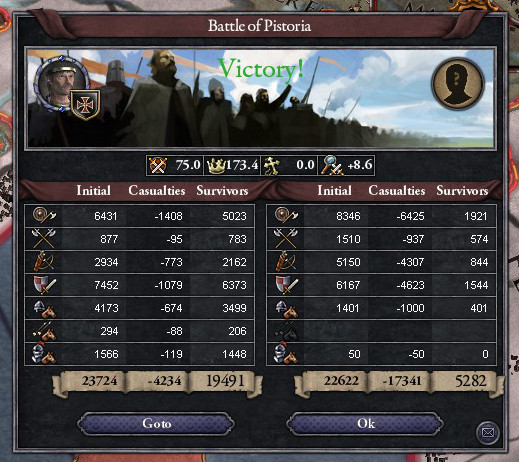 A rearguard action in nearby Canefro by Papal forces was unsuccessful in fending off Gothic pursuers, and the last remains of the Papal army were there obliterated. 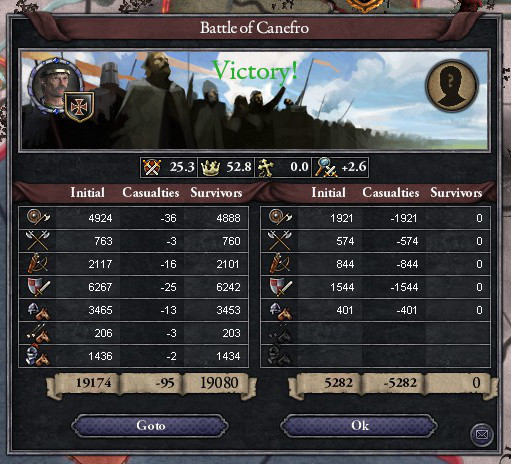 The surprise destruction of the Papal army sent the Holy Roman court into a sheer panic. If the Goths had wanted to, they could have forced the Papacy to surrender then and there. 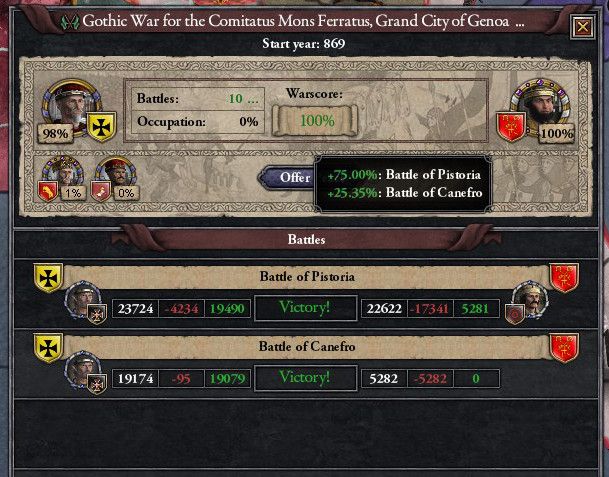 Instead, however, the allied armies spent another half-year besieging Ligurian towns before peace demands were sent to the Pope. The Carthagennans, eager to make their own dramatic gesture, attacked a small Papal force near Rome itself, before sending their army back up to Liguria.  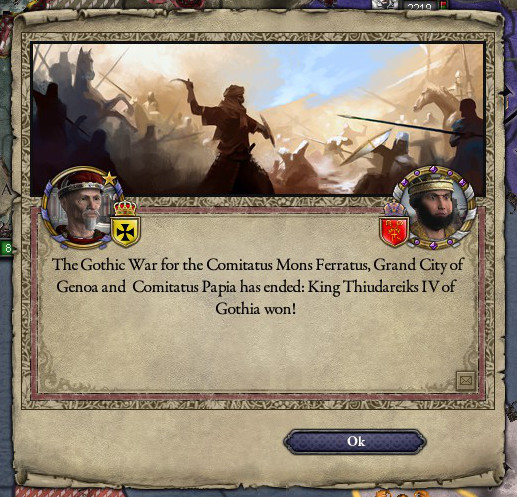  Gothia and Italy after the Peace of 871 And so, with their army destroyed almost at first contact with the enemy, and with Liguria already falling into enemy hands, the Papacy surrendered in 871. The counties of Mons Ferratus, Genoa and Papia- ‘Pawei’ to the Germanic Goths- all fell into the hands of King Thiudareiks IV. The next item of concern that Thiudareiks IV attempted to address was the matter of royal authority. With Liguria in his pocket and the Pope freshly defeated, the king sought once more to expand the powers of the crown. 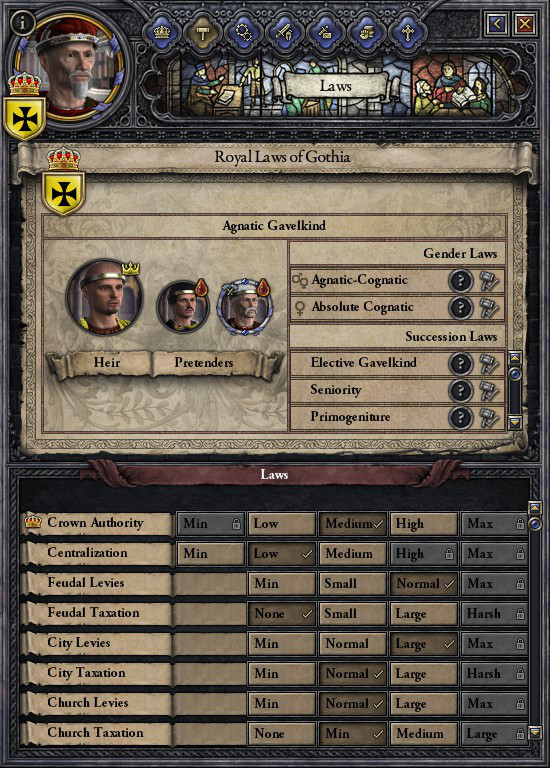 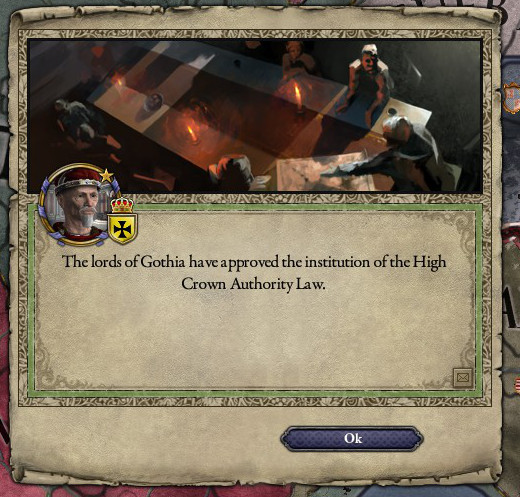 The Codex Theodericus was thus updated yet again, further cementing the power of the crown over the dukes and other vassals of Gothia. It is worth noting that these changes in Gothic law put forward by the 8th and 9th-century Triarian kings, while doing much to advance the preeminence of the monarchy, did not signify any serious move away from feudalism. While the king’s power within Gothia grew, and legal limitations were put upon vassals in terms of feuding and inheritance law, feudal vassals themselves were still an absolute necessity for the realm’s administration. The Gothic kings had done almost nothing to actually centralize the realm and bring additional lands under their direct crown rule; Gothia’s monarchy was growing stronger, but it still lacked the capacity to administer all the realm’s territories directly.  A fine example of this growing monarchical preeminence was the introduction of a new denarius coin, stamped during the later part of King Thiudareiks IV’s reign. Originally engraved with an ornate portrait of the king on one side and the Gothic Cross on the other, the details of the coin have greatly degraded over time, due to the debasement of the metals used to mint the currency. When it was new, however, the coin likely would have served as a great celebration of the monarchy, and introduced an (idealized) image of the king to the many people of the realm who had never seen their notional lord even once in their lifetimes. 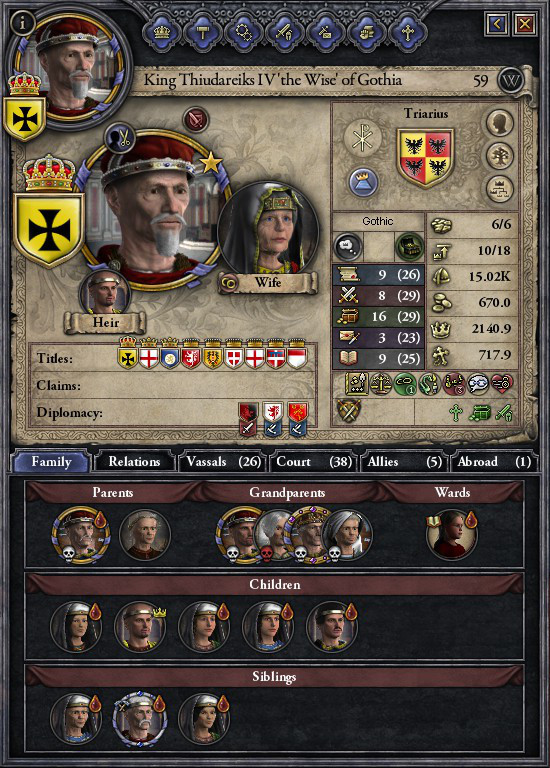 Due in part to his personal stewardship skills, and in part due to the work during his reign to strengthen the Gothic realm and the Gothic crown, King Thiudareiks IV is thus remembered in many popular works as “Thiudareiks the Wise”. 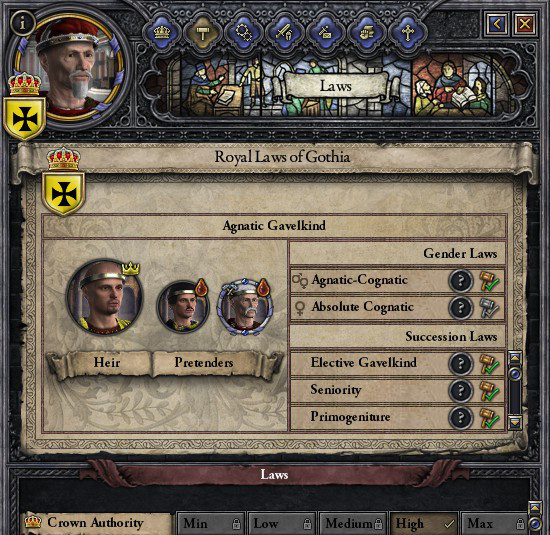 One action late in Thiudareiks IV’s reign sticks out, not quite hewing to the Triarian trend of increasing monarchical power. The issue of gavelkind succession had haunted the dynasty ever since the division of Gothia and loss of Armorica a century prior. With the crown’s authority higher than ever, it was a perfect opportunity to address the issue and formally change succession over to a unified primogeniture system- but the king chose the moment to formally abandon strict agnatic law instead. Why? 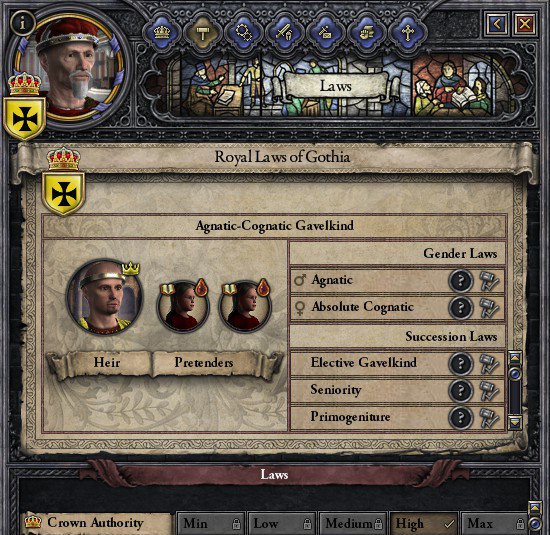 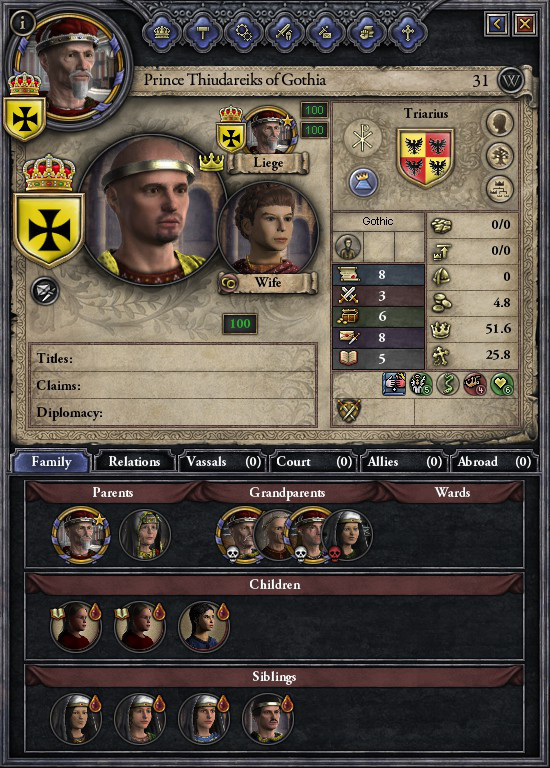 The reasoning behind it all was the king’s grandchildren- while Thiudareiks IV had a perfectly fine male heir, Prince Thiudareiks, the prince himself had no male heirs. If both King and Prince Thiudareiks had died at that point, while strict agnatic law was still in force, the crown would have passed to the children of the king’s brother, a branch of the family the king loathed for obscure reasons. Rather than seeing his brother’s family continue in the line of succession, Thiudareiks IV had taken the momentous opportunity to change the importance of gender in inheritance law. Of course, Prince Thiudareiks then had a son a year later, rendering the law change moot. King Thiudareiks IV, in turn, took a turn for the worse, and died shortly thereafter in 875. 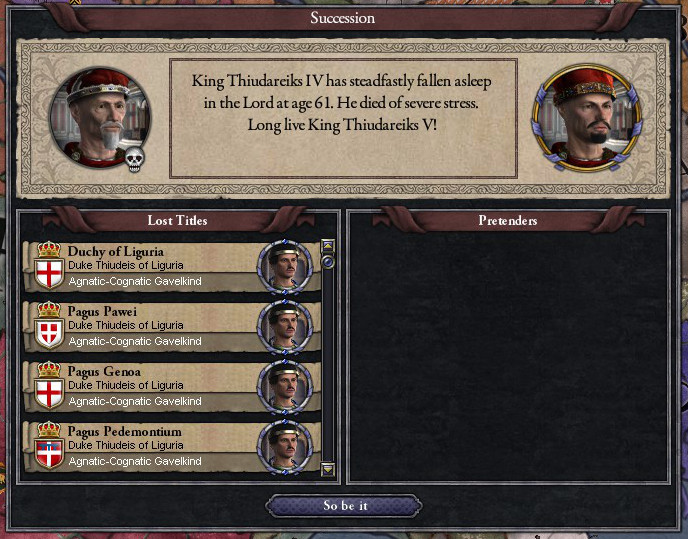 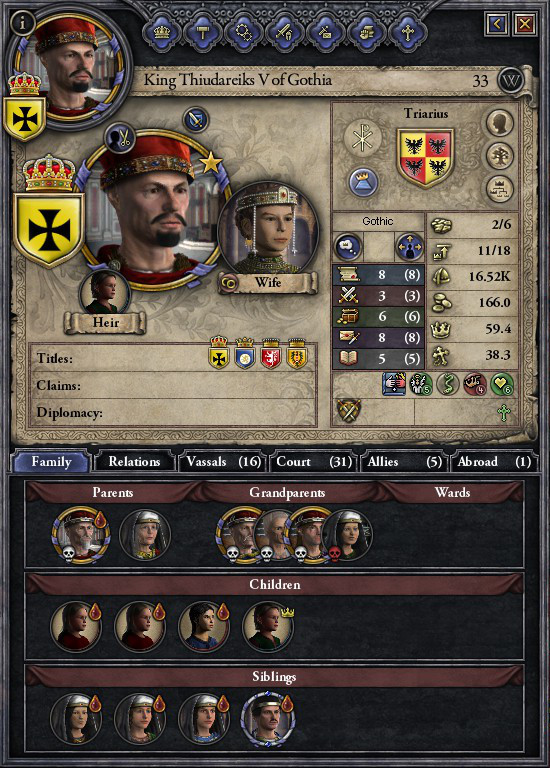 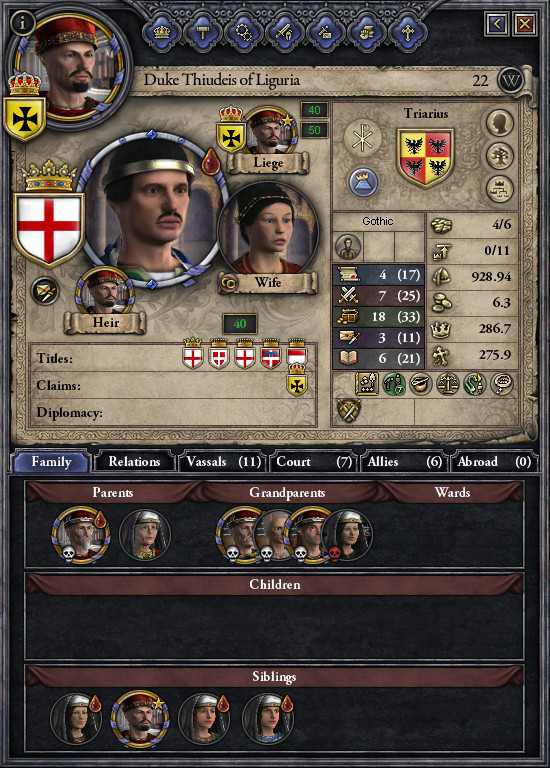 Prince Thiudareiks was now King Thiudareiks V. Although not as able an administrator as his father, Thiudareiks V was married to a very capable Greek princess, Kale of Malta, and by the time of Thiudareiks V’s coronation they had already become the parents of four children, including their first son, also named Thiudareiks. Due to the gavelkind laws still in effect, the Ligurian lands taken by Thiudareiks IV had passed over Thiudareiks V in favor of the new king’s brother, Prince Thiudeis, who consolidated the Italian provinces into his own Duchy of Liguria. 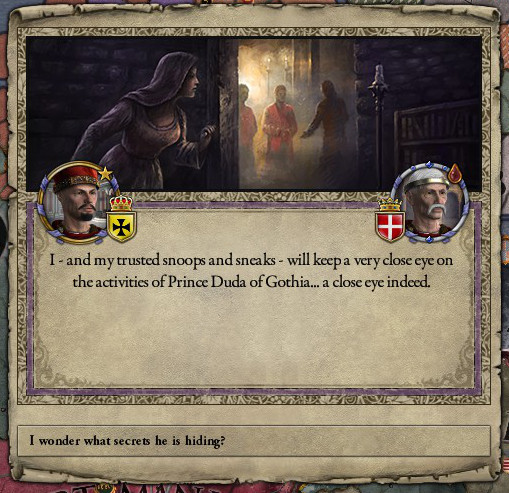 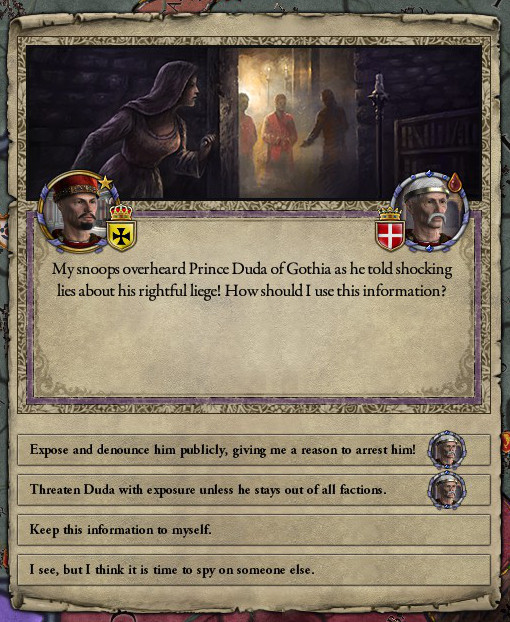 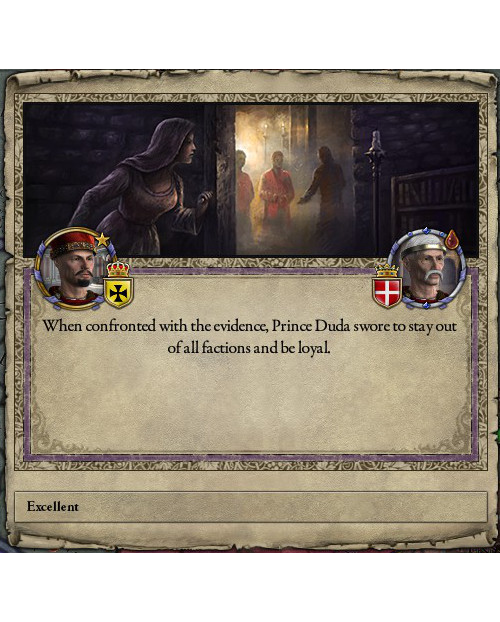 Aware that he lacked the same long-term relationships with his vassals that his father had enjoyed, Thiudareiks V quickly turned to espionage and intrigue as his main focus in life. Fearful of rebellion, the new king spent enormous amounts of time working on methods of coercing and blackmailing his subjects, always seeking ways of disrupting plots and silencing those who would not willingly back down from their own schemes. For this, the king would later be widely remembered as ‘Thiudareiks the Shadow’.   Espionage was not the king’s sole concern, however. Like his predecessors, Thiudareiks V expressed an interest in spreading Orthodox Christianity, largely due for political reasons. Like his predecessors, the king sent missionaries abroad. As part of this pattern, Patriarch Haimareic of Gothia was sent to Alanic court in Krakyqaew in an attempt to convert their king, Kul, to the true faith. Like his predecessors, Thiudareiks had little expectation of such an effort succeeding. 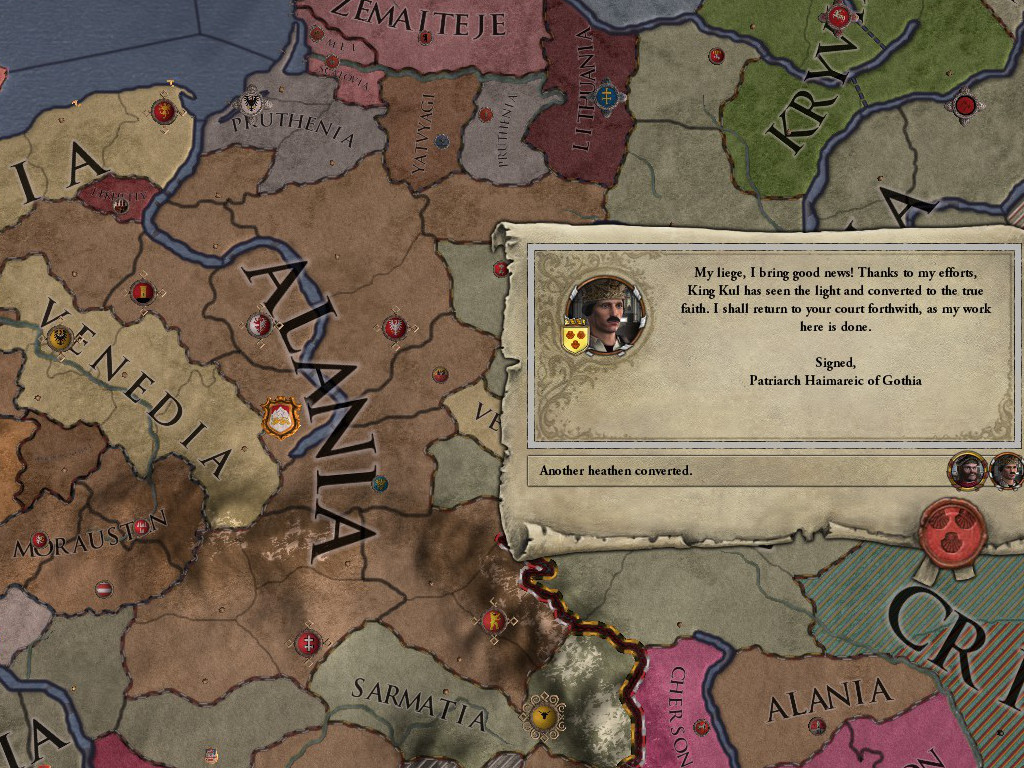 The surprise in Lugdunum when Haimareic announced the King of Alania’s conversion to Orthodoxy not even a year after his arrival in Alania thus astounded everybody. Christianity had scarcely penetrated the lands beyond the frontiers of the former Roman Empire at all, and yet with one conversion Christianity now reached the Vistula, and boxed the pagans of Germania in on the west, south and east. With Alania’s conversion- and the conversion did stick- Christianity at last began expanding beyond the shadow of old Rome. 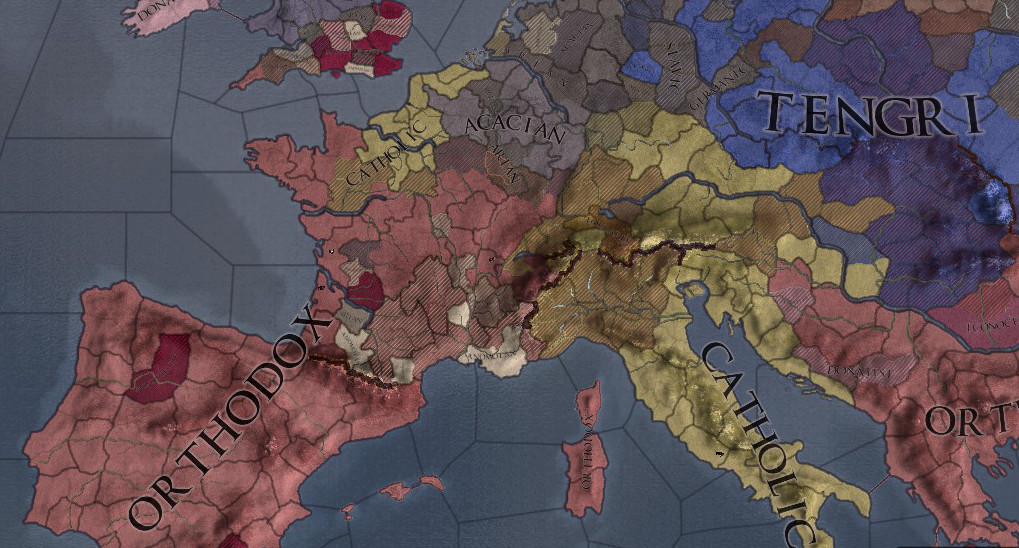 Closer to home, Orthodoxy was also doing well in Western Europe. Arianism had been almost entirely eradicated in Gaul, and the radical Anomoean strain had gained little ground in Septimania. Catholic Armorica was losing ground to Gothia, and much of northern Italy was, by the late 800s, under Orthodox control, due in part to the Kingdom of Avaria converting away from Catholicism. Religion was not the only aspect of European society that was becoming a little more Roman during this period, however. 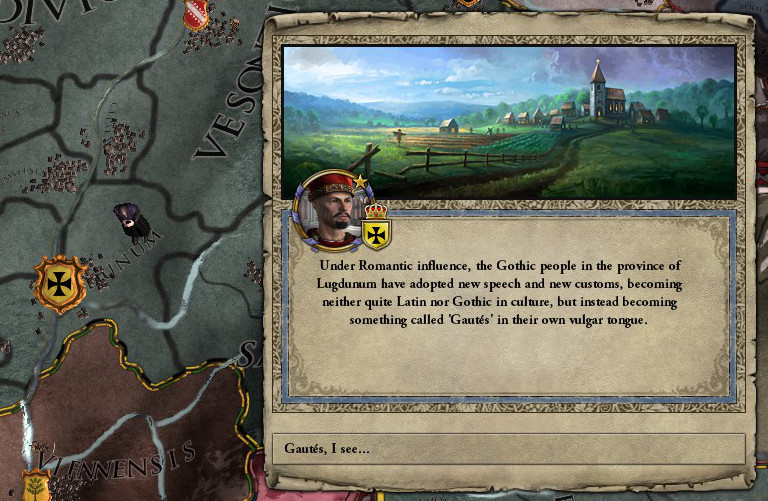 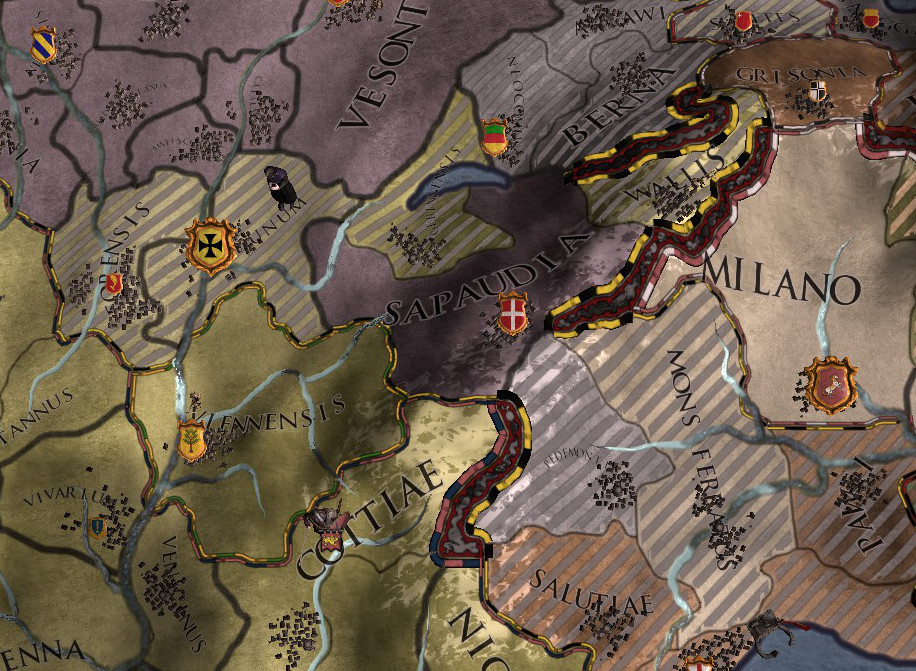 Goths and Romans through the Early Middle Ages had maintained separate identities, but as Gothic connections to the Roman world strengthened, with increased contact with the Carthagennans and Italians, the conversion of the Goths to Roman Orthodoxy, and a growing bureaucracy that continued to use Latin in administration, the Germanic Goths gradually began to take on a more Romantic character. In Gaul, this took on the form of the emerging Gautés culture in the 9th century. Linguistically, the Gautés language was firmly rooted in Vulgar Latin origins, but owed much of its phonology to the Germanic Gothic tongue. Culturally, the emergence of Gautés more closely linked Goths to the native Gallo-Roman population, and gradually helped integrate the ruling classes of Gothia with the great masses of Gaul. Gautés wasn't the only culture emerging from the stew of old migrators and Latin peoples at this time- the developed of Italian culture in Avaria continued unabated, with the late 9th century marking the first time an Avarian king was widely recognized as Italian rather than distinctly Avar. Meanwhile, in the Goth-controlled regions of northern Italy a cousin of Gautés culture, Taurinjèis, a culture that owed its name to the city of Turin and the ancient Taurini people who once inhabited the region, was likewise beginning to emerge. In the late 9th century, these changes had not fully engulfed Gothia, but the shift from Germanic Gothic to a Romantic Gothic culture had begun. New identities were being developed, replacing old ones that dated back to the days of the Roman Empire. The Triarius dynasty of Gothia had already struggled to keep Gothia together when religions began to change- would they be able to do the same when the very culture of Gaul changed? 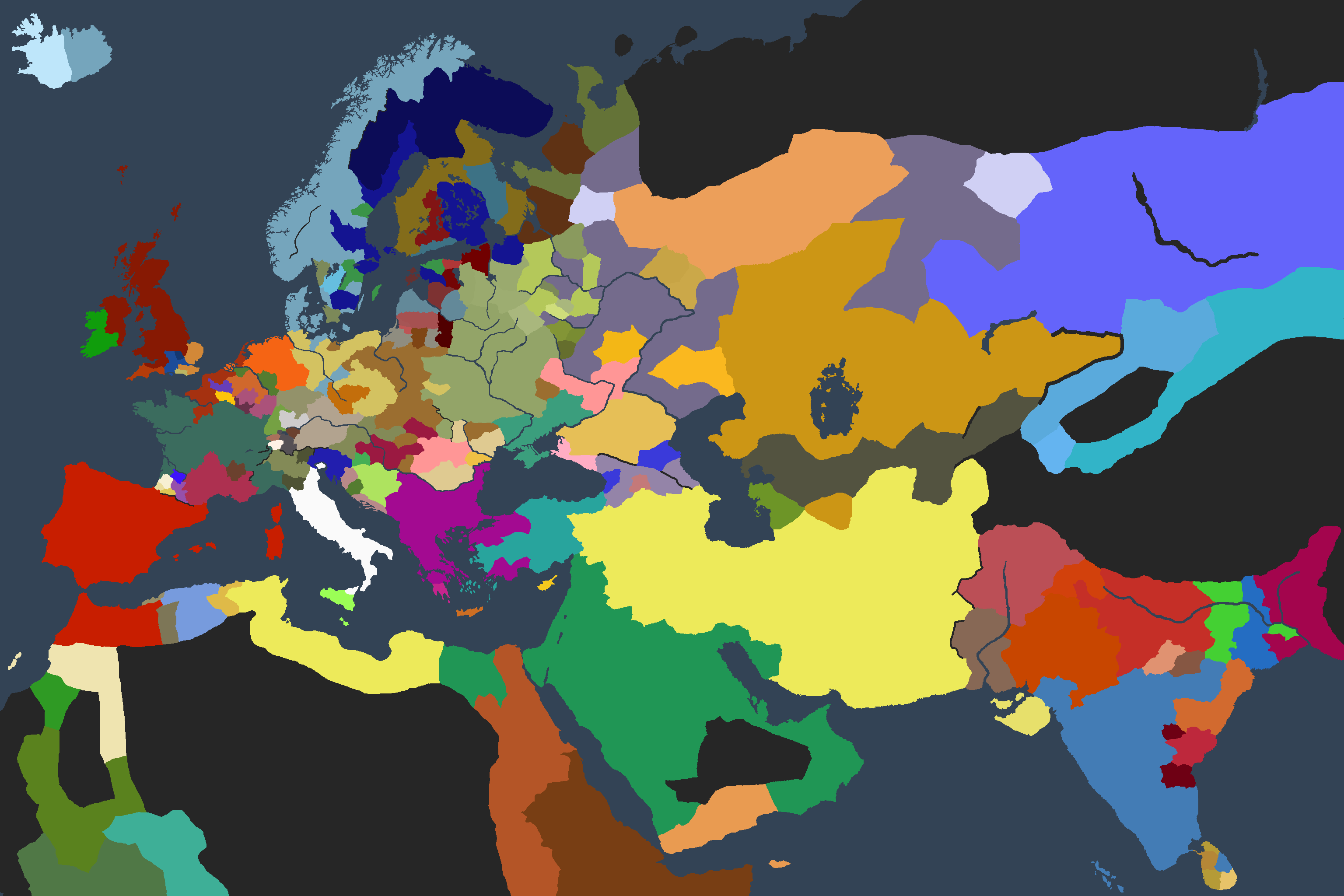 The Medieval World of 889 Ofaloaf fucked around with this message at 20:11 on Oct 24, 2015 |
|
|
|
It's back
|
|
|
|
|
Holy Mazda, Batman! The Sassanids are still kicking rear end! Also, very pleased with our further development as Gautes and looking forward to Seljuk.
|
|
|
|
I'm disappointed the Holy Roman Empire failed so spectacularly. I was hoping they'd have been able to put up more of a fight. Guess they can always rebound though. Spreading the faith and culture shifting though, how exciting!
|
|
|
|
The Abbasids are losing ground fast. Half of Egypt was conquered by loving Nubia. I'm hoping some Africanu refugees help the king establish a new Rome in Alexandria. 
Lord Cyrahzax fucked around with this message at 20:57 on Oct 24, 2015 |
|
|
|
First we abandon the true Avarian faith for the Carthaginian Orthodoxy, and now we start using the very Roman LANGUAGE as a basis for our own too? If this continues I smell a revolt coming up!
|
|
|
|
YF-23 posted:I'm disappointed the Holy Roman Empire failed so spectacularly. I was hoping they'd have been able to put up more of a fight. Guess they can always rebound though. Spreading the faith and culture shifting though, how exciting! And then, of course, once you smash in a realm's army once, it's really hard for the AI to rebound in time to retake the initiative in a war.
|
|
|
|
Ofaloaf posted:The biggest weakness of the HRE is that, being a theocracy and all, it can't arrange normal marriage alliances. As far as single realms go it's still fairly strong, and I don't think I've even seen one HRE civil war yet, but if it's not in a holy war, nobody's going to be even able to ally with it. Is the HRE a titular title? I'm really surprised that it hasn't really tried expanding all that much, especially against those Sicilian counts.
|
|
|
|
Still holding out for a Druidic Reformation on the Isles.
|
|
|
|
Luhood posted:First we abandon the true Avarian faith for the Carthaginian Orthodoxy, and now we start using the very Roman LANGUAGE as a basis for our own too? If this continues I smell a revolt coming up! Lord Cyrahzax posted:Is the HRE a titular title? I'm really surprised that it hasn't really tried expanding all that much, especially against those Sicilian counts.
|
|
|
|
Knowing that the Super Picts may soon cross the channel to push our poo poo in fills you with determination.
|
|
|
|
Also oh god I finally decided to look at Nubia in detail, and
|
|
|
|
YES
|
|
|
|
oh my god
|
|
|
|
How does that happen though, did we vote to make it a republic and I just forgot? E: not to mention that I don't think I have ever seen a republic be that aggressive
|
|
|
|
I don't think there's even any counties led by a mayor in Nubia or Abyssinia at scenario start. I'm honestly not sure what happened there.
|
|
|
|
What religion are the nubians?
|
|
|
|
Ofaloaf posted:Also oh god I finally decided to look at Nubia in detail, and I'd like to formally apologize for anything bad I said about people who voted against Great Nubia the first time around
|
|
|
|
....So trade is going to be more interesting now.
|
|
|
|
Ofaloaf posted:Also oh god I finally decided to look at Nubia in detail, and
|
|
|
|
If that survives we need to make sure it can colonize in EU4.
|
|
|
|
The Great Somalian Republic's spirit lives on in Nubia. Too bad it is an inland republic though.
|
|
|
mythomanic posted:What religion are the nubians? Judging by the shields, some variety of Christian probably.
|
|
|
|
|
The republic of Prester John.Fox Ironic posted:Holy Mazda, Batman! The Sassanids are still kicking rear end! Is that suprising? They have a huge empire and had access to great holy wars right off the bat. Persnally I hope a Jewish Seljuk kicks their faces in. e: What's the orange state in Yemen? Randarkman fucked around with this message at 03:10 on Oct 26, 2015 |
|
|
|
Randarkman posted:The republic of Prester John. I half expected them to have collapsed into civil war by now. Jewish Seljuk sounds awesome, but I have a feeling he'll probably go North instead of South in this timeline (like he has done in many of my CK2 playthroughs when Persia is especially strong). Edit: if we push more into Italy and take Rome, I could see us taking over the "Not Roman Rome" role that Charlemagne had in OTL and forming a renewed Holy Roman Empire under a Monarch instead of the Pope. An interesting political move would be propping up an independent Patriarch in Rome, perhaps splitting off into another Orthodox schism that could replace Catholicism in EU4. Perhaps something inspired by both Roman Orthodoxy and our Arian roots? Or we could just go Catholic for maximum crusading! Fox Ironic fucked around with this message at 17:53 on Oct 26, 2015 |
|
|
|
mythomanic posted:What religion are the nubians? Fox Ironic posted:Perhaps something inspired by both Roman Orthodoxy and our Arian roots? Or we could just go Catholic for maximum crusading!
|
|
|
|
Ofaloaf posted:I've enabled crusading mechanics for Orthodoxy, actually. Tweaked the triggers for starting off the Crusades, too. Awesome! I assume the Ecumenical Patriarch calls the Crusade? Do Catholics still have Crusades as well? Fox Ironic fucked around with this message at 15:53 on Oct 28, 2015 |
|
|
|
What's that blueish kingdom in Anatolia that seems to have completely replaced the Khalufinids? Are they Rumi or straight up Greek/Levantine? Also, I really wish the Byzantines would conquer Smyrna already, that gap is driving me nuts every time I see it.
|
|
|
|
Chapter 27: Romantic Notions 889-907 Through the later parts of the 9th and early 10th centuries, Romanization of Gothia continued apace, both culturally and politically. During this period, the Goths of Gallia were increasingly intervening in Carthagennan politics, involving themselves in Spanish dynastic intrigues and likewise themselves engaging in more "Carthagennan"-style plots. The gradual shift of Gothic culture from Germanic 'Gutans' to Romantic 'Gautés' was well underway among the lesser patricians of Gaul, but as of yet few of the greater lords of the realm had openly embraced the shift. The Triarian kings of Gothia likewise persisted in following a policy of dual language usage, with medieval Latin retaining primacy in government and religious duties, while Germanic Gothic continued serving as the language of court ceremonies and the nobility. Nonetheless, Roman ways were becoming more prominent in Gothia, and no one better exemplified this Romanization of the Goths than the kings of Gothia themselves. King Thiudareiks V, although not as capable a steward of the realm as his father, was nonetheless a hungry man. Upon the death of his father, the holdings of Thiudareiks IV had been divided between Thiudareiks V and his brother, Thiudeis. Lands were evenly divided on a ducal basis, not a provincial basis, thus leaving Thiudareiks V and Thiudeis a duchy each. The problem in that was that the Duchy of Lugdunensis, which Thiudareiks V inherited, consisted of one county under crown rule, while Thiudeis inherited the Duchy of Liguria and direct control of four counties within it. 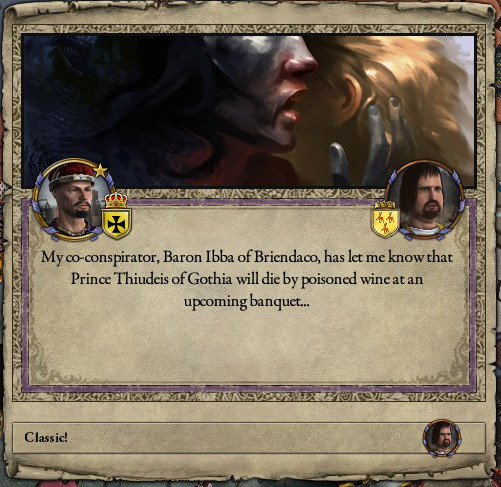 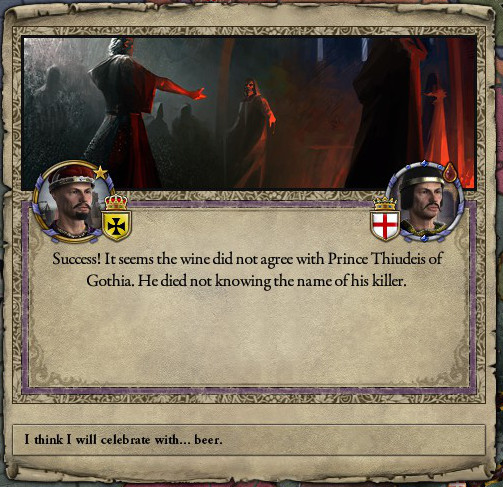 Duke Thiudeis' reign was not long, however, and according to court records he died of complications from a drinking binge. Liguria then briefly passed to Thiudeis' son, Iairaimias, before the child died in an unfortunate accident in the countryside and the Italian lands passed on to King Thiudareiks. 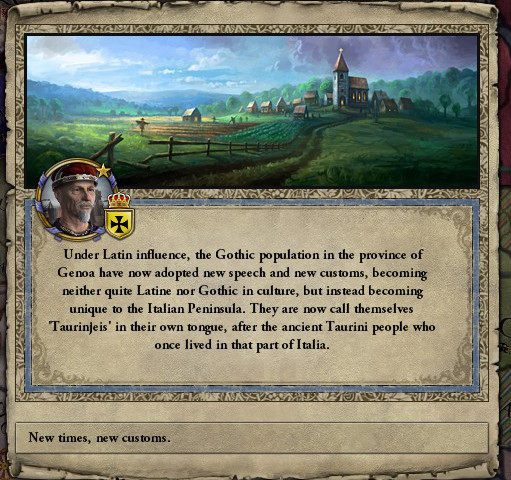 Alongside the Romanization of politics and intrigue, cultural Romanization continued apace, with Gothic Liguria notably becoming predominantly Taurinjèis in over just a generation's time. Despite mounting evidence of these new Romance cultures gaining significant influences in the provinces in the late 9th and early 10th centuries, during Thiudareiks V's reign these shifts had not trickled upwards to the ruling classes. 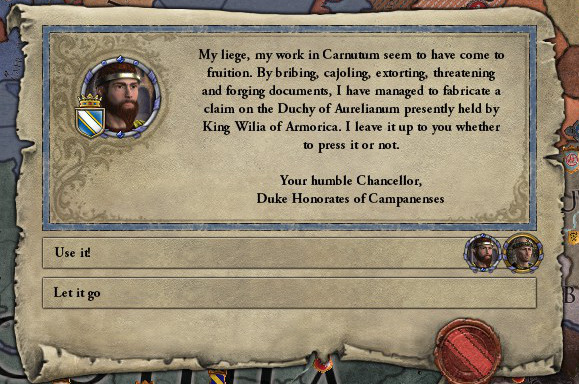 With revenues from Liguria now flowing directly into the royal coffers, Thiudareiks V was able to enact a very aggressive policy of expansion. Funds were used to help Gothic scholars "discover" ancient documents which alleged that certain portions of Armorica and Aquitania were legally part of Gothia. Other parts of the treasury were set aside to pay for improvements to royal holdings in Lugdunum, including new barracks and improvements to the royal keep and town's fortifications. 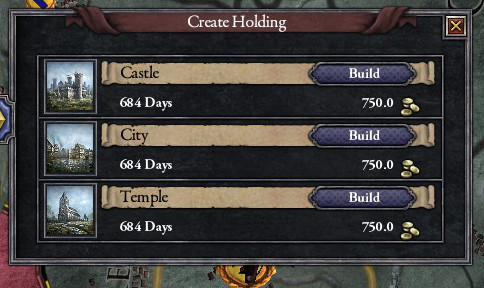 In fact, revenues from Liguria and Lugdunum were high enough that the king was able to pay for the construction of a new castle near the capital. Construction began in 894, and by 896 the complex had been completed. So pleased was Thiudareiks V with the fortifications built, he dubbed the new holding the Castra Ansa, likening it to the grand fortifications built in classical times. 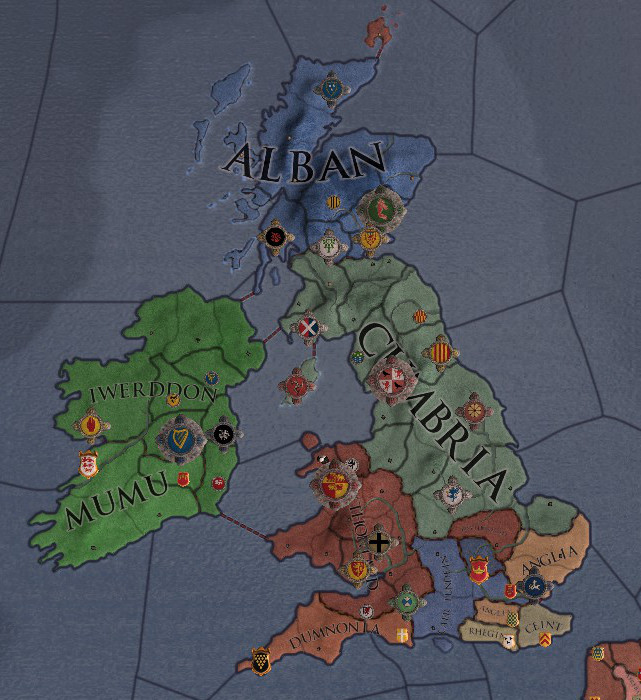 New fortifications were becoming a more important need, moreso in northern Gothia than near the capital. The pagan Britons were steadily conquering Britain, even after the death of King Cynwared the Whisperer and the splintering of his 'Brythoniaid' realm into four separate kingdoms. Christendom was being steadily pushed back to the Channel, and as of yet Gothia had not been able to effectively intervene and reconquer Britain for the Cross. The schismatic realm of Armorica still controlled the ports closest to Britain and were thus the most able to involve themselves in British affairs, but as of yet they had done nothing. If Gothia cared about the welfare of British Christianity, the Armorican coast would have to be seized at some point in the near future. 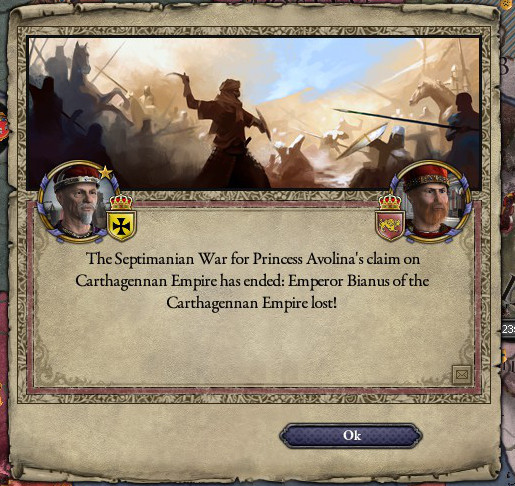  Britain was not the only place where Christianity was imperiled. To Gothia's south, Roman Orthodoxy was replaced with Arian Anomoeanism in 897, when a claimant managed to win the crown of the Carthagennan Empire and usurp the Roman throne. The Goths, late allies of the Carthagennans, were shocked by this takeover, and attempted to assist a Lusitanian rebellion against the Gallic usurper. 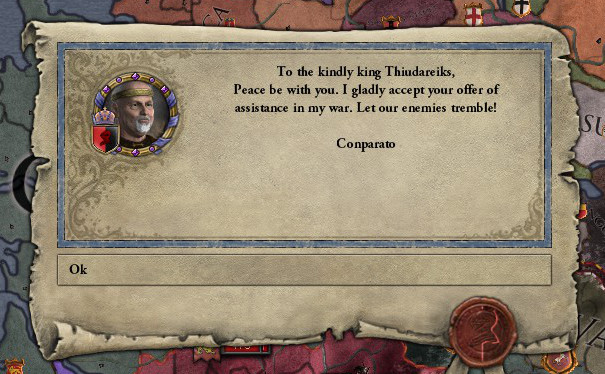 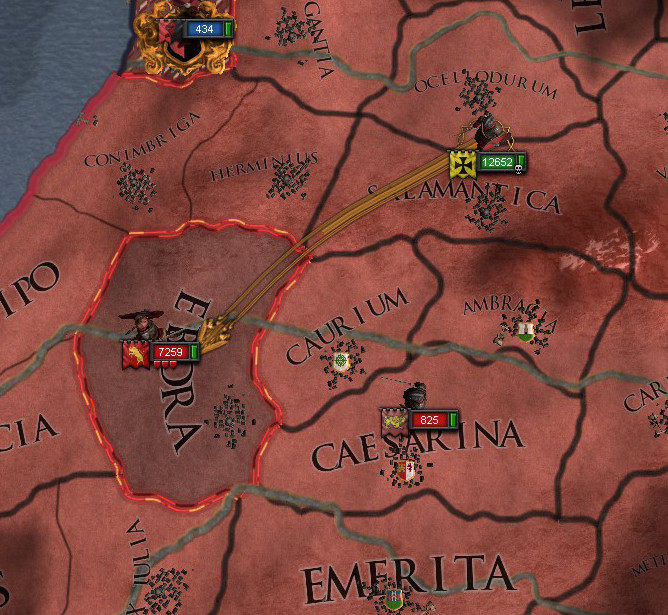 King Thiudareiks fielded perhaps too many men at once, sending roughly 22000 men across the Pyrenees to assist the Carthagennan rebels. However, the Pyrenees were not a developed region, and there was little food available as the Goths marched across Spain. Of those 22000 men who were sent to fight, only 11000 made it to the rebel-held province of Ebora. The resulting battles were so disastrous for the Goths, the Gothic Duke of Turonum raised the banner of rebellion back in Gothia and attempted to overthrow the king.   Having learned his lessos from the disastrous intervention in Spain, Thiudareiks responded to this insurrection by raising more men... and then waiting. By the time the rebellious duke's men crossed the Loire river, they had succumbed to some tremendous attrition rates, while the king's men were still fit and healthy. 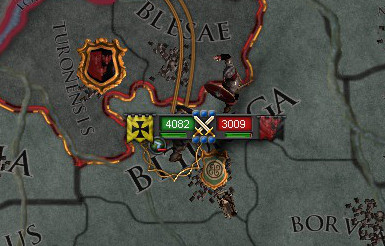 While loyalist soldiers were able to tie up the rebels in several battles, King Thiudareiks now had time to address the actual casus belli of the war... 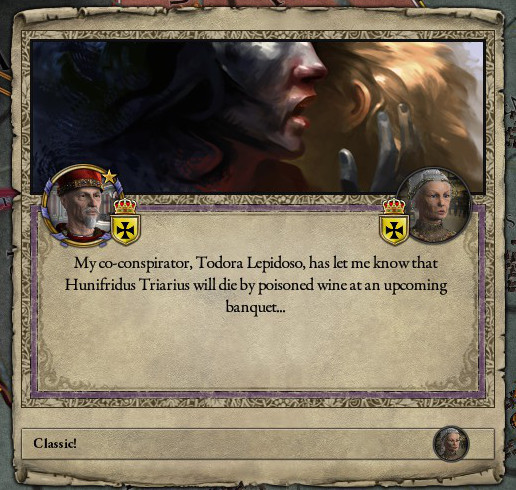 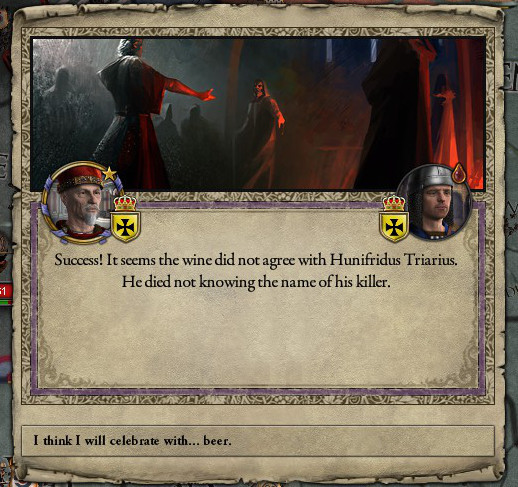 With Hunifridus, the king's nephew, dead, the Duke of Turonum had no claimant to fight for, and the war fizzled to an end. King Thiudareiks V was called 'the Shadow' for good reason! While letting war plans sit on the backburner for some years, fate decided it was time to give Thiudareiks V an incredible stroke of luck. 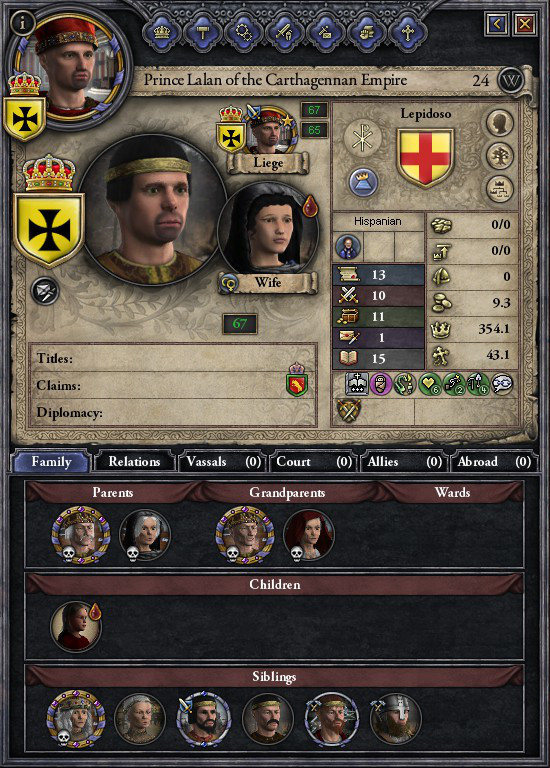 Another pretender, a Gallo-Roman heretic of the Septimanian ruling dynasty named Eufemïen, had taken over the Carthagennan Empire. The son of the deposed emperor, Prince Lalan, fled to the Gothic court and submitted himself before the king for royal protection. King Thiudareiks readily agreed, and with his power over the prince, married one of his daughters to Prince Lalan- matrilinearlly. Any children they had would be of the Gothic royal family's dynasty, but would have imperial Roman blood flowing through its veins and a claim on the Roman throne. Shortly after the marriage, in fact, Lalan fathered a daughter, and it is said that King Thiudareiks cackled gleefully for days afterward. 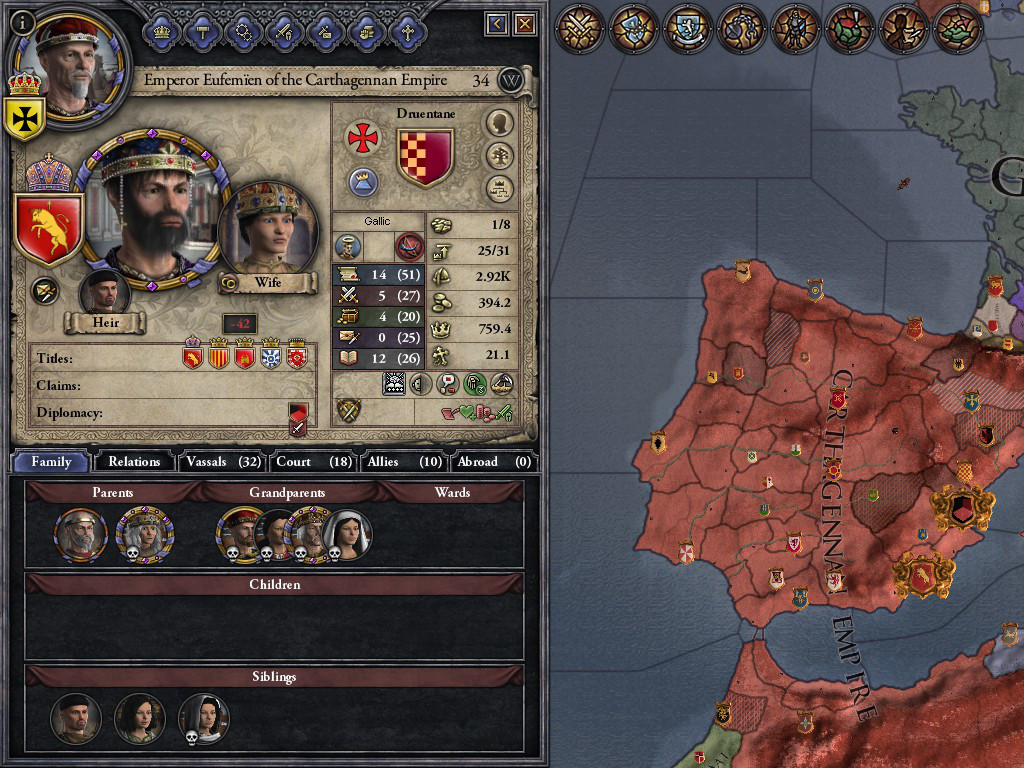 And so, in 903, Thiudareiks V declared war on the Carthagennan Empire again. Like before, a primary goal was to simply dislodge the Anomoean Arians from the Roman throne before that heresy could take root in Spain, but now the king had an extra dynastic incentive to win. 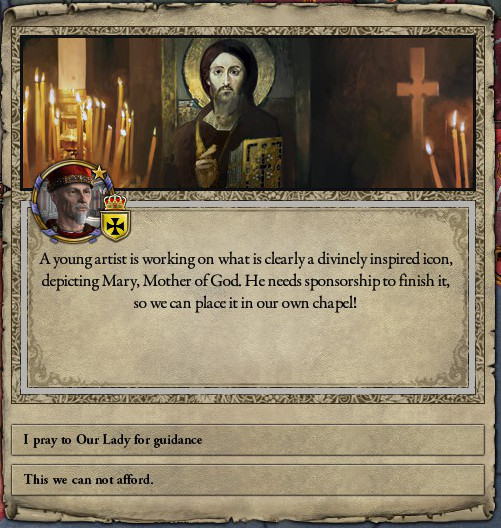 An interesting artifact from this time now resides in the old royal cathedral in the capital. An icon of the Virgin Mary, one of the oldest icons in the cathedral's collection, originates from Gothia during the Carthagennan War. It shows Mary carrying the baby Jesus in her arms, in itself a common depiction of the Theotokos, but both Mary and Jesus are wearing royal garments of the Gothic monarchy. The detail given to the clothes is such that it is commonly thought that the artist had direct access to the Gothic court, suggesting perhaps that Thiudareiks V or a close member of the court personally sponsored the creation of the icon. Royal assertions of dominance were not limited to iconography, of course. Gothic troops marched into Hispania once more in early 904- and this time, they were sent over in several separate armies, rather than one mass, thus avoiding the deadly attrition which destroyed the Gothic army in the previous war. 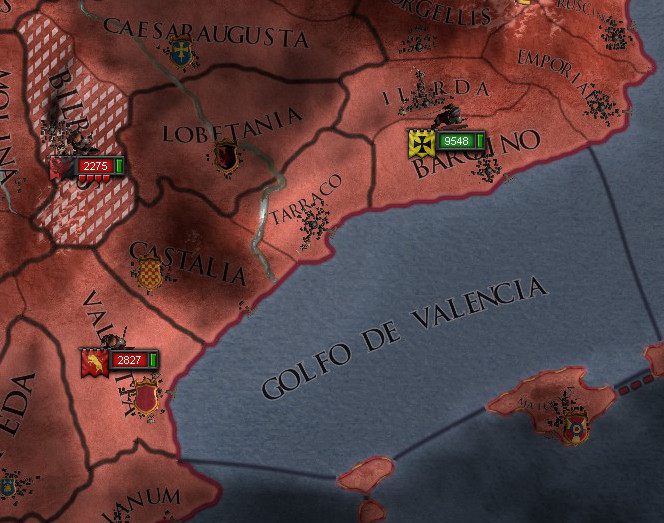 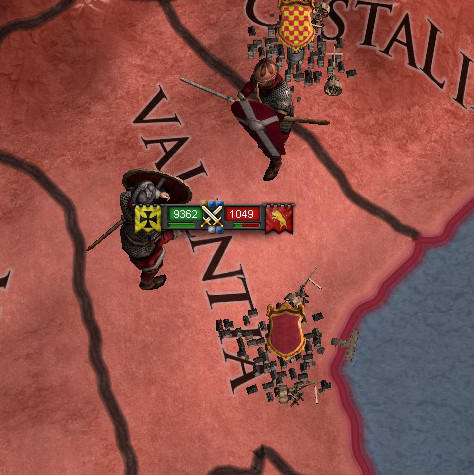 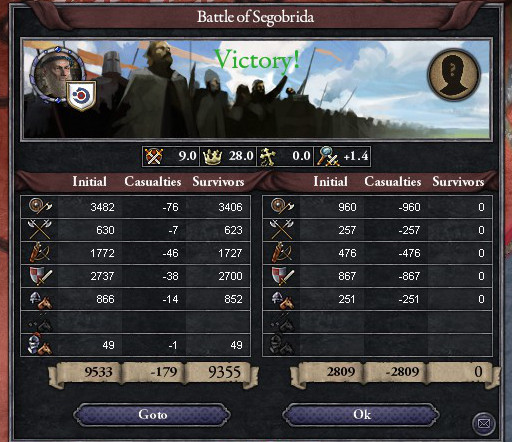 Gothic troops first clashed with Romans in March of 904, near Valentia. A few Gothic armies had regrouped after crossing the Pyrenees and, led by the Duke of Theifalia, fell upon a smaller Carthagennan army north of Carthago Nova. Outnumbering the enemy over 3 to 1, the Goths handily crushed the Imperial forces. 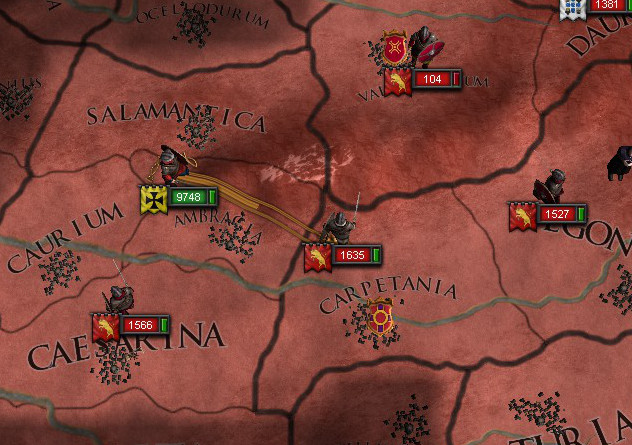 That proceeded to be the general pattern of battles throughout the Carthagennan War. It is very likely that at several points throughout the conflict, Emperor Eufemïen managed to raise more levies than the Goths were ever able to field at one time. The Romans never were able to consolidate their men together into one massive force, however, leaving the Goths to obliterate Spanish armies several times over. 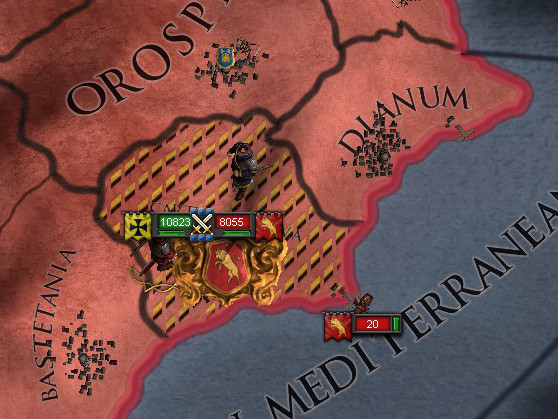 The closest the Carthagennans ever came to parity with Gothic forces in the field was during the Battle of Murcia (905), when roughly 8000 Romans, led by the governor of Volubilis, attempted to take on nearly 11000 Goths and relieve the besieged Carthagennan capital. 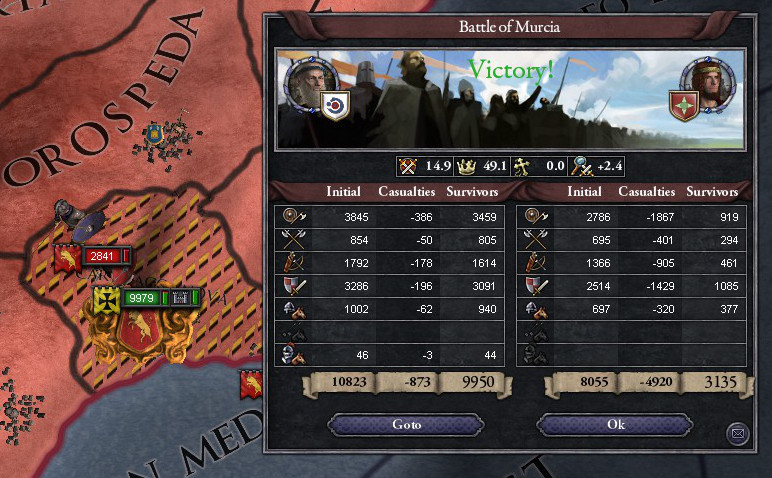 They failed, Carthago Nova fell to the Goths, and remained under Gothic occupation until the end of the war. 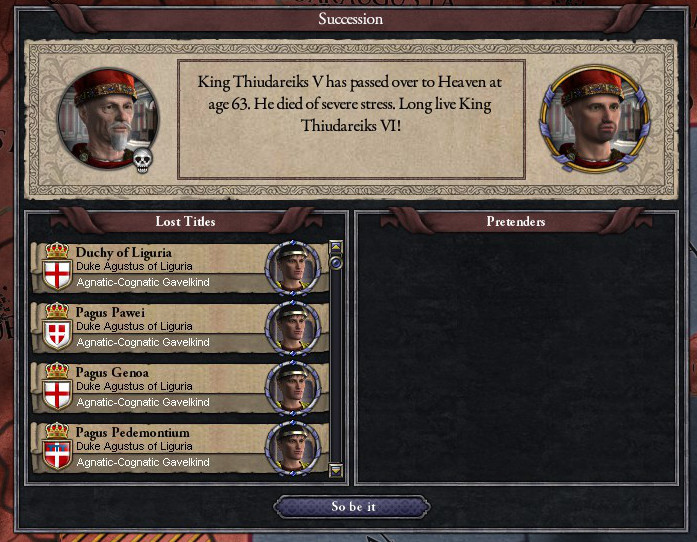  The same year as the Battle of Murcia, King Thiudareiks V died, passing the crown on to his son, Thiudareiks VI. With Thiudareiks V's death, Liguria again passed on to the new king's brother and away from direct royal control, thus stymieing Thiudareiks VI's finances. The new king was further hampered by persistent rumors of an extramarital affair with a male courtier, which left him with fewer supporters at court than would have otherwise likely been the case. 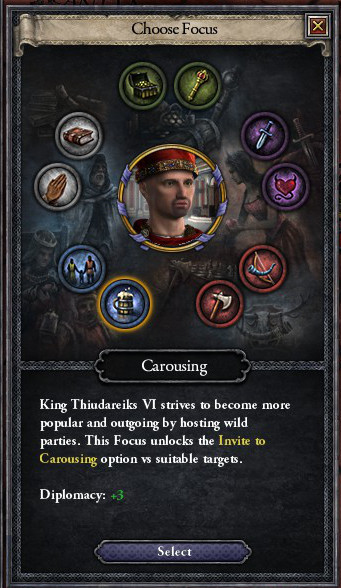 Aware of the rumors and ill will towards him, Thiudareiks VI spent most of his reign carousing, trying to personally ingratiate himself with his vassals by showering parties upon the nobility. 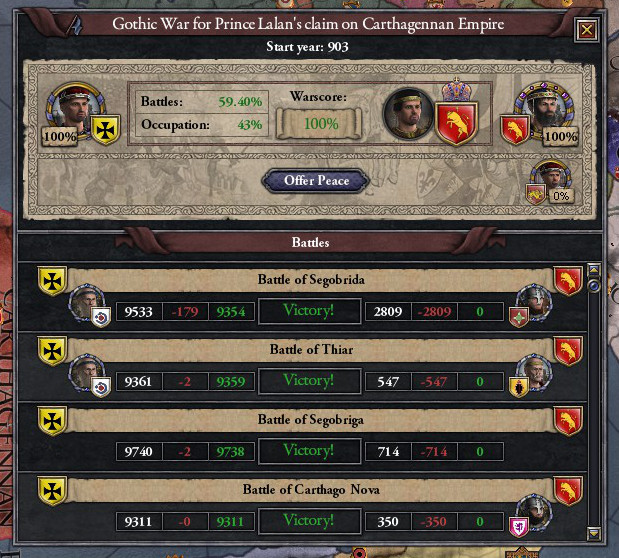 If nothing else, the new king at least had a good reason to party in 907. On December 30th, 906, the usurper Emperor Eufemïen fled the Carthagennan Empire, and the Goths' favorite for the throne, Prince Lalan, was hailed as the empire's new leader. 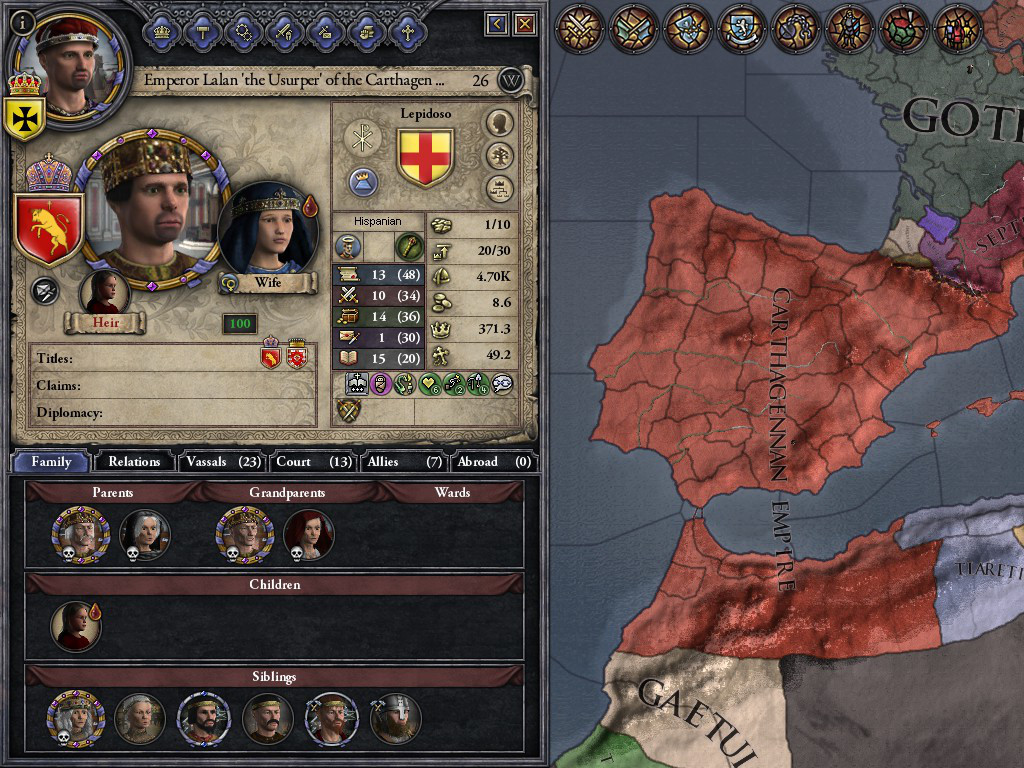 Orthodox rule had been restored to the Roman realm, and when the crown passed on to his heir, a Goth would directly rule the Romans. The world in January of 907 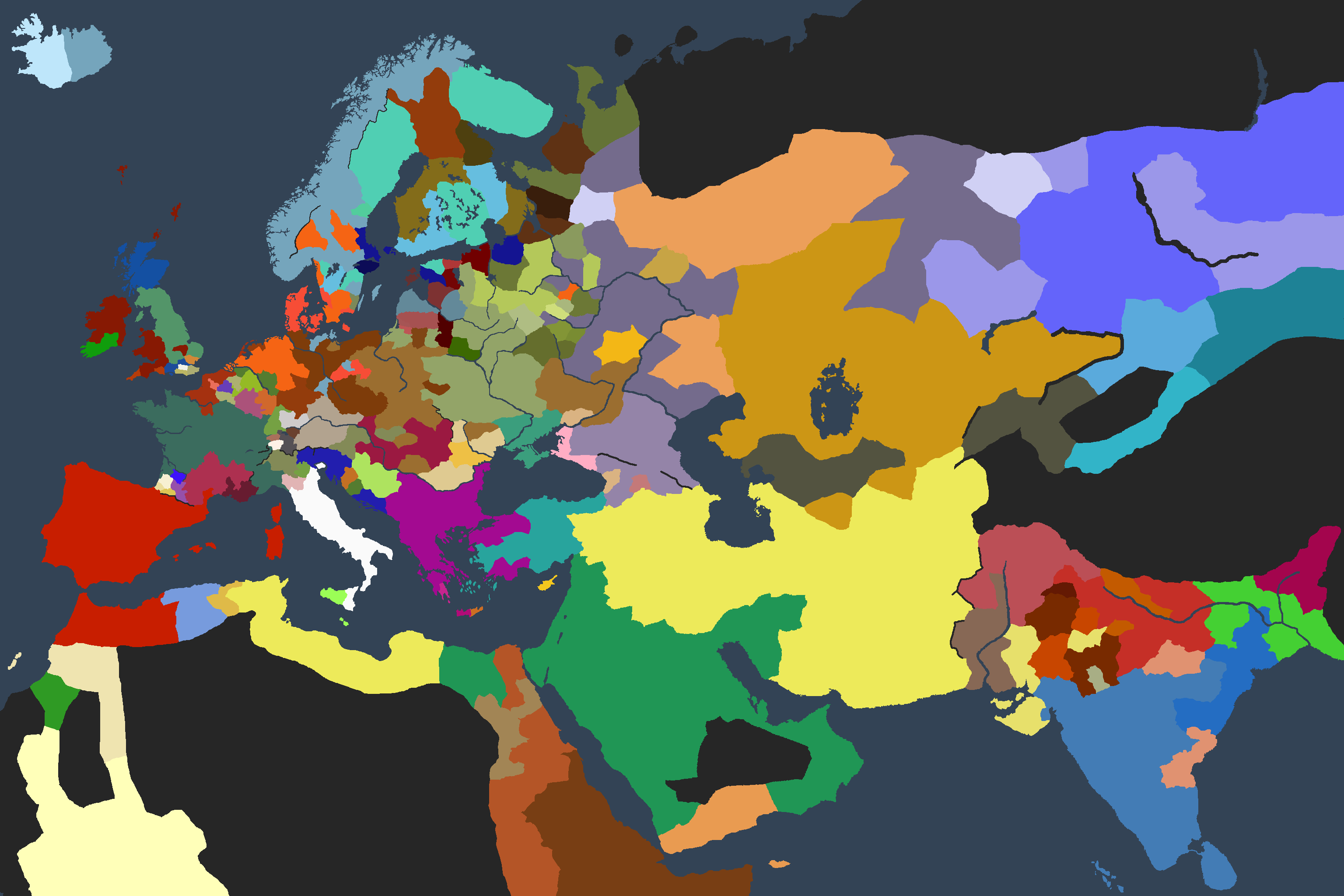
|
|
|
|

|
| # ? Apr 28, 2024 00:28 |
|
Ofaloaf posted:
 Things are starting to look up for the Goths.
|
|
|



















